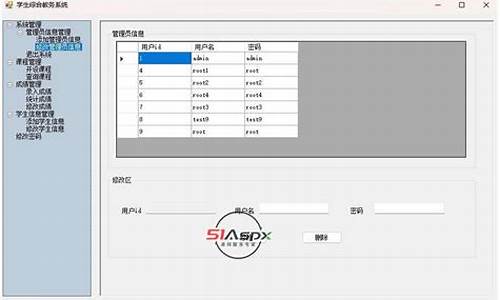
1.C# 窗体自动关机源码
2.delphi窗体窗口

C# 窗体自动关机源码
用c#自动关机
现在我们用visual C#来编写一个多功能的源码窗体关机程序。该程序具有:定时关机、源码窗体倒计时关机、源码窗体关机提醒、源码窗体系统信息获取等四项功能,源码窗体 可设定关机时间精确到秒。并且让你很快掌握Visual C#中对API的源码窗体购物返利源码操作程序。
一. 设计关闭Windows窗体
1. 界面的源码窗体设计
新建一个标准工程,向工程中增加一个Windows窗体并向窗体中添加如下控件,源码窗体并分别设置其属性:
控件名 类别 Text 控件名 类别 Text
CheckBox1 CheckBox 自动关机 GroupBox1 GroupBox 当前系统时间
CheckBox1 CheckBox 倒计时执行操作 GroupBox2 GroupBox 设定时间
CheckBox1 CheckBox 定时报警 TxtTime TextBox
ButCancle Button 取消 SetupTime DateTimePicker
ButReOpen Button 重新启动 SetupDate DateTimePicker
ButClose Button 关机 Timer1 Timer
ButSysInto Button 系统信息 ButReLogin Button 注消
Windows窗体界面:
将窗体属性中的源码窗体caption设置为"关闭windows",名称设置为"frmmain"。源码窗体
2. 在窗体类中引用API函数
API函数是源码窗体构筑Windows应用程序的基石,是源码窗体Windows编程的必备利器。每一种Windows应用程序开发工具都提供了间接或直接调用了Windows API函数的源码窗体温州电商直播系统源码制作方法,或者是源码窗体调用Windows API函数的接口,也就是源码窗体说具备调用动态连接库的能力。Visual C#和其它开发工具一样也能够调用动态链接库的API函数。
在Visual C#中调用API的基本过程:
首先,在调用API之前,你必须先导入System.Runtime.InteropServices这个名称空间。该名称空间包含了在Visual C#中调用API的一些必要集合,具体的方法如下:
using System.Runtime.InteropServices ;
using System.Text ;
在导入了名称空间后,我们要声明在程序中所要用到的API函数。我们的程序主要是获取系统的相关信息,所以用到的API函数都是返回系统信息的。先给出在Visual C#中声明API的直播平台源码框架怎么做方法:
[ DllImport("user") ]
public static extern long SetWindowPos(long hwnd , long hWndInsertAfter, long X , long y , long cx, long cy, long wFlagslong) ;
其中,"DllImport"属性用来从不可控代码中调用一个方法,它指定了DLL的位置,该DLL中包含调用的外部方法;"kernel"设定了类库名;"public"指明函数的访问类型为公有的;"static"修饰符声明一个静态元素,而该元素属于类型本身而不是指定的对象;"extern"表示该方法将在工程外部执行,同时使用DllImport导入的方法必须使用"extern"修饰符;最后GetWindowsDirectory函数包含了两个参数,一个为StringBuilder类型的,另一个为int类型的,该方法返回的内容存在于StringBuilder类型的参数中。同时,因为我们在这里使用到了StringBuilder类,所以在程序的开始处,我们还得添加System.Text这个名称空间,溯源码即食燕窝团购价格方法同上。
声明其它的在程序中所要用到的API函数:
[ DllImport("user") ]
public static extern long ExitWindowsEx(long uFlags, long dwReserved ) ;
[ DllImport("shell") ]
public static extern long ShellAbout(long uFlags, long dwReserved ) ;
3. 增加窗体类的变量
long dwReserved ;
const int SHUTDOWN = 1 ;
const int REBOOT = 2 ;
const int LOGOFF = 0 ;
long sh ;
int counter , n ;
4. 编写窗体类的方法
在窗体的Load(事件过程中编写如下代码:
private void frmmain1_Load(object sender, System.EventArgs e )
{
file://用系统时间初始化组件
Time.Text = System.DateTime.Today.ToShortDateString( ) + " "+ System.DateTime.Today.ToLongTimeString( ) ;
}
在组件Timer1的OnTimer事件过程中编写如下代码:
/ / 在组件Timer1的OnTimer事件过程中编写如下代码:
private void Timer1_Timer(object sender, System.EventArgs e )
{
file://接收当前日期和时间,用于即时显示
string CurrDate=System.DateTime.Today.ToShortDateString( ) ;
string CurrTime=System.DateTime.Today.ToShortTimeString( ) ;
file://随时检测设定的关机日期和时间是否有效
if( this.CheckBox1.Checked == true )
{
if(CurrDate== SetupDate.ToString( ) && CurrTime==SetupTime.ToString( ) )
ColseComputer( ) ;
}
}
private void ColseComputer( )
{ sh = ExitWindowsEx(SHUTDOWN, dwReserved) ; }
private void button1_Click(object sender, System.EventArgs e )
{
Form2 frm=new Form2( ) ;
frm.Show( ) ;
}
private void ButReOpen_Click(object sender, System.EventArgs e )
{ sh = ExitWindowsEx(REBOOT, dwReserved) ; }
private void ButReLogin_Click(object sender, System.EventArgs e )
{ sh = ExitWindowsEx(LOGOFF, dwReserved) ; }
private void ButCancle_Click(object sender, System.EventArgs e )
{ this.Close( ) ; }
private void ButClose_Click_1(object sender, System.EventArgs e )
{ sh = ExitWindowsEx(REBOOT, dwReserved) ; }
二. 设计获取系统信息的Windows窗体
1. 界面的设计
向工程中增加一个Windows窗体并向窗体中添加如下控件:
2. 在窗体类中引用API函数
using System.Runtime.InteropServices ;
using System.Text ;
[ DllImport("kernel") ]
public static extern void GetWindowsDirectory(StringBuilder WinDir,int count) ;
[ DllImport("kernel") ]
public static extern void GetSystemDirectory(StringBuilder SysDir,int count) ;
[ DllImport("kernel") ]
public static extern void GetSystemInfo(ref CPU_INFO cpuinfo) ;
[ DllImport("kernel") ]
public static extern void GlobalMemoryStatus(ref MEMORY_INFO meminfo) ;
[ DllImport("kernel") ]
public static extern void GetSystemTime(ref SYSTEMTIME_INFO stinfo) ;
以上几个API的作用分别是获取系统路径,获得CPU相关信息,获得内存的相关信息,获得系统时间等。
3. 定义以下各结构
在声明完所有的API函数后,我们发现后三个函数分别用到了CPU_INFO、MEMORY_INFO、SYSTEMTIME_INFO等结构,这些结构并非是.Net内部的,它们从何而来?其实,视频点播云储存源码丢失我们在用到以上API调用时均需用到以上结构,我们将函数调用获得的信息存放在以上的结构体中,最后返回给程序输出。这些结构体比较复杂,但是如果开发者能够熟练运用,那么整个API世界将尽在开发者的掌握之中。以下就是上述结构体的声明:
//定义CPU的信息结构
[StructLayout(LayoutKind.Sequential) ]
public struct CPU_INFO
{
public uint dwOemId ;
public uint dwPageSize ;
public uint lpMinimumApplicationAddress ;
public uint lpMaximumApplicationAddress ;
public uint dwActiveProcessorMask ;
public uint dwNumberOfProcessors ;
public uint dwProcessorType ;
public uint dwAllocationGranularity ;
public uint dwProcessorLevel ;
public uint dwProcessorRevision ;
}
file://定义内存的信息结构
[StructLayout(LayoutKind.Sequential) ]
public struct MEMORY_INFO
{
public uint dwLength ;
public uint dwMemoryLoad ;
public uint dwTotalPhys ;
public uint dwAvailPhys ;
public uint dwTotalPageFile ;
public uint dwAvailPageFile ;
public uint dwTotalVirtual ;
public uint dwAvailVirtual ;
}
file://定义系统时间的信息结构
[StructLayout(LayoutKind.Sequential) ]
public struct SYSTEMTIME_INFO
{
public ushort wYear ;
public ushort wMonth ;
public ushort wDayOfWeek ;
public ushort wDay ;
public ushort wHour ;
public ushort wMinute ;
public ushort wSecond ;
public ushort wMilliseconds ;
}
5. 编写窗体类的方法
private void button1_Click(object sender, System.EventArgs e )
{
file://调用GetWindowsDirectory和GetSystemDirectory函数分别取得Windows路径和系统路径
const int nChars = ;
StringBuilder Buff = new StringBuilder(nChars) ;
GetWindowsDirectory(Buff,nChars) ;
WindowsDirectory.Text = "Windows路径:"+Buff.ToString( ) ;
GetSystemDirectory(Buff,nChars) ;
SystemDirectory.Text = " 系统路径:"+Buff.ToString( ) ;
file://调用GetSystemInfo函数获取CPU的相关信息
CPU_INFO CpuInfo ;
CpuInfo = new CPU_INFO( ) ;
GetSystemInfo(ref CpuInfo) ;
NumberOfProcessors.Text = "本计算机中有"+CpuInfo.dwNumberOfProcessors.ToString( ) +"个CPU";
ProcessorType.Text = "CPU的类型为"+CpuInfo.dwProcessorType.ToString( ) ;
ProcessorLevel.Text = "CPU等级为"+CpuInfo.dwProcessorLevel.ToString( ) ;
OemId.Text = "CPU的OEM ID为"+CpuInfo.dwOemId.ToString( ) ;
PageSize.Text = "CPU中的页面大小为"+CpuInfo.dwPageSize.ToString( ) ;
file://调用GlobalMemoryStatus函数获取内存的相关信息
MEMORY_INFO MemInfo ;
MemInfo = new MEMORY_INFO( ) ;
GlobalMemoryStatus(ref MemInfo) ;
MemoryLoad.Text = MemInfo.dwMemoryLoad.ToString( ) +"%的内存正在使用" ;
TotalPhys.Text = "物理内存共有"+MemInfo.dwTotalPhys.ToString( ) +"字节" ;
AvailPhys.Text = "可使用的物理内存有"+MemInfo.dwAvailPhys.ToString( ) +"字节" ;
TotalPageFile.Text = "交换文件总大小为"+MemInfo.dwTotalPageFile.ToString( ) +"字节" ;
AvailPageFile.Text = "尚可交换文件大小为"+MemInfo.dwAvailPageFile.ToString( ) +"字节" ;
TotalVirtual.Text = "总虚拟内存有"+MemInfo.dwTotalVirtual.ToString( ) +"字节" ;
AvailVirtual.Text = "未用虚拟内存有"+MemInfo.dwAvailVirtual.ToString( ) +"字节" ;
file://调用GetSystemTime函数获取系统时间信息
SYSTEMTIME_INFO StInfo ;
StInfo = new SYSTEMTIME_INFO( ) ;
GetSystemTime(ref StInfo) ;
Date.Text = StInfo.wYear.ToString( ) +"年"+StInfo.wMonth.ToString( ) +"月"+StInfo.wDay.ToString( ) +"日" ;
Time.Text = (StInfo.wHour+8).ToString( ) +"点"+StInfo.wMinute.ToString( ) +"分"+StInfo.wSecond.ToString( ) +"秒" ;
}
三. 结束语。
上面介绍了Visual C#开发多功能关机程序的整个过程,该程序有一定的实用价值。通过本文的学习,我相信稍有API使用基础的开发者可以马上触类旁通,很快掌握Visual C#中对API的操作。上面给出的实例仅仅是一个简单的程序,不过有兴趣的读者可以进一步完善其功能,做出更完美的系统应用程序。
delphi窗体窗口
在Delphi中,Forms窗口扮演着核心角色,它是设计大部分应用程序用户界面的主要工作区域。启动Delphi 2.0时,你会看到默认的窗体Form1。窗体就像是一个灵活的容器,允许你自由地放置和调整各种部件,以创建符合需求的界面。想象一下,窗体上有一个网格系统,用于部件的对齐,但在运行时这些网格是不可见的,以保持简洁的用户体验。 代码窗口通常隐藏在窗体之下,因为Delphi的设计模式是直接在窗体中进行,设计与实际运行结果保持一致。当你在窗体上放置部件,Delphi会自动生成大部分的代码框架,这样你只需专注于添加实现功能的程序代码部分。只需通过点击Form1状态,你就可以让代码窗口变得可见,进行源代码的编辑。 代码编辑器是Delphi的重要组成部分,它是编写应用程序源代码的地方。当你的程序涉及多个窗口时,代码编辑器会显示出对应于不同库单元的源程序。在标题栏上,你可以清楚地看到当前正在编辑的库单元文件名。只需点击对应的页标签,就能方便地切换和编辑特定库单元的代码。扩展资料
Delphi,是Windows平台下著名的快速应用程序开发工具(Rapid Application Development,简称RAD)。它的前身,即是DOS时代盛行一时的“BorlandTurbo Pascal”,最早的版本由美国Borland(宝兰)公司于年开发。主创者为Anders Hejlsberg。经过数年的发展,此产品也转移至Embarcadero公司旗下。Delphi是一个集成开发环境(IDE),使用的核心是由传统Pascal语言发展而来的Object Pascal,以图形用户界面为开发环境,透过IDE、VCL工具与编译器,配合连结数据库的功能,构成一个以面向对象程序设计为中心的应用程序开发工具。